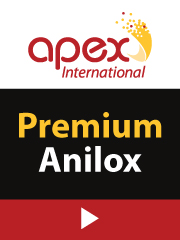Energy-Curable Inks
- Published: December 01, 2002, By Rod Balmer, Flint Ink Corp.
What is the state of UV/EB technology today, and where could it lead in the future? Here are answers to some frequently asked questions.
Ultraviolet (UV) and electron beam (EB) ink systems are on the minds of most converters today. Advancements have broadened applications and reduced costs, making the technology worth a closer look.
Q: What is the definition of UV/EB ink systems and how do they work?
A: Energy-curable inks are so-called because they contain certain materials that form free radicals or ionic species when exposed to UV light or high-energy electrons. These reactive species then combine with other materials to build a polymer network.
UV-curable inks are cured using ultraviolet radiation in the 200-400 nm waveband of the electromagnetic spectrum. The process is started (initiated) by using a blend of photo-reactive (light-reactive) materials called photoinitiators. In the most commonly used chemistry, photoinitiators cleave to produce free radicals when exposed to UV light. The free radical species, now in an excited state, need to pass on this new energy. They search out other materials called acrylates that contain an unsaturated double bond, and together they propagate a polymer chain.

Acrylates can be in the form of a simple monomer unit or a higher molecular weight material called an oligomer. An oligomer, in essence, produces the backbone of the finished ink or coating. The free radicals produced on the acrylated material will continue to react further with acrylate oligomers or monomers, building the polymer chain until termination. Termination occurs when there are no more available free radicals to react in the system.
In another UV chemistry known as cationic, initiating species are produced by exposure of the photoinitiator to UV energy. This process uses materials that are different in chemistry from traditional free-radical chemistry. Not only are the photoinitiators based on different chemistries, but the prepolymers used are based on cycloaliphatic epoxy chemistry. Because of the materials used in this process, it is best suited for the flexographic printing process.
The major difference between UV and EB is that an EB system will not have a photoinitiator in the formulation. Instead, high-energy accelerated electrons are focused in a beam and react with the ink or coating. These electrons will seek out the unsaturated double bonds of both acrylate monomers and oligomers and transfer their energy to produce free radicals and initiate the polymer chain propagation. Just like UV, these free radicals will react with other areas of unsaturation on the acrylated materials, forming a polymer chain until the reaction is terminated.
Q: What are the most popular packaging applications for UV/EB ink systems?
A: Some of the most common applications for energy-curable inks are cosmetic, CD, video, and DVD packaging. They also are used for all types of labels and folding cartons for secondary food and non-food packaging.
Q: What are the advantages and disadvantages of UV/EB?
A: Energy-curable systems are gaining popularity for a number of reasons. Foremost is the fact they cure in approximately one-tenth of a second, as compared to conventional heatset and sheet-fed litho ink systems, which can take from several minutes to a few days to dry, respectively. Thus, the turnaround of energy-cured litho jobs can rival that of flexo and gravure and significantly improve productivity.
Another advantage is the consistent high gloss exhibited by energy-curable coatings that are applied in-line over energy-curable inks. The ability to coat in-line also allows for virtually immediate processing of the package, including die-cutting, folding, gluing, and foil stamping.
Energy-curable products also offer significantly improved end-use resistance properties. Since the chemistry creates a polymer chain, it produces an ink surface that is highly resistant to many chemicals and abrasive scuff.
Also important is the fact that UV/EB ink systems are 100 percent solids and typically contain no VOCs. Effectively this means the system is “greener” than most conventional ink systems. If formulated and cured correctly, UV/EB inks will have lower taint and odor than many conventional oxidizing types of ink.
In addition to the aforementioned benefits, energy-curable inks also offer advantages of improved handling. In the past, energy-curable inks had a high level of skin irritancy. Today's conscientious formulators create products with skin-irritancy levels comparable to some conventional inks containing common petroleum distillates.
Of course there are some costs associated with these advantages. In general, one-time equipment costs range from $100,000 for a very basic setup to $450,000 for a more complex installation.
Additionally, some ink products require NBR (nitrile-butadiene rubber) or EPDM (ethylene-propylene diene monomer) press rollers and alternative blankets, which may require specific press washes in order to prevent excessive shrink, swell, or degradation.
Finally, the inks themselves may cost more than conventional inks. However, all of these costs must be weighed against the increased performance gained when using an energy-curable system.
Q: How are shortcomings being addressed?
A: Ink-curing equipment, UV lamps, and EB-curing units have declined steadily in cost. This is especially evident in the case of EB-curing units, which have decreased from more than $1 million in 1990 to as little as $250,000 today. UV-curing costs also have decreased over time, and it's logical to believe this trend will continue into the future.
Q: What applications dictate sheet- or web-fed printing?
A: Oxygen in the curing area inhibits the production of free radicals in inks or coatings. Because a web configuration helps maintain a nitrogen atmosphere within the curing unit, all EB presses are web fed in order to maintain the nitrogen needed for sufficient curing. Some EB presses print roll-to-roll, while others include additional processing, such as die-cutting, folding, and window patching. Often, UV web presses that print such end-use products as cereal boxes from a roll also incorporate in-line finishing.
Other applications that adopt a web process are UV flexographic printing (flexible packaging) and UV offset printing (direct mail and business forms).
Q: How can a UV/EB formulation be optimized?
A: For maximum value, the formulator should utilize the most progressive techniques known to create UV/EB inks. One of the most advanced methods is through a scientific screening of materials where their contribution to the formula is measured and statistically analyzed versus the associated cost. Once this exercise is complete, scientifically generated data exists ensuring the formulation has been optimized for performance and value.
Q: How can a converter maximize the relationship between UV/EB inks and coatings?
A: Special consideration is needed when selecting an ink and coating for a specific application. The inks and coatings should be formulated to give a synergistic effect in order to optimize gloss and ensure proper inter-coat adhesion. It also is necessary to understand the end use of the product, curing conditions, and other post-printing modifications such as foil stamping.
If a low-odor system is needed for packaging applications, it is necessary to ensure both the ink and the coating are low-odor formulations. Sourcing ink and coating together from the same supplier should alleviate most problems experienced by converters.
Q: What are most recent advances in UV/EB technologies?
A: Conventional printers desiring the performance characteristics of UV ink coupled with the easy runnability of a conventional system gave rise to the birth of hybrid technology. While performance characteristics of hybrid products may vary between suppliers, a converter should be able to expect these basic tenets:
-
The ability to run on all types of conventional presses equipped with appropriate in-line UV curing.
-
No need to change rollers, blankets, plates, or press chemistry.
-
The ability to achieve high gloss levels in-line.
-
Freedom to clean ink from rollers and blankets with conventional washes, such as certain water-miscible types.
-
Runnability similar to that of a conventional oil-based system.
Additional advancement has been made in newer-generation full UV and EB chemistries. The window of operation has been expanded considerably, providing excellent ink and water balance on press. The net effect is a much easier ink to run, allowing press operators to concentrate on other printing parameters. These systems also offer the same minimal shrink and swell as that of hybrid technology.
There are also many other advanced technologies being developed that will make additional contributions to the converting environment.
Q: What do you see for the future of UV/EB technologies?
A: While performance gains and operational efficiencies continue to develop, higher cost remains the primary barrier inhibiting the popularization of UV/EB technologies in the printing industry. The future of this technology is dependent on whether its cost can be reduced to near that of conventional ink systems.
Rodney Balmer received degrees in printing technology and in chemistry — printing ink technology from the Univ. of Manchester, England. He joined Flint Ink Corp., Ann Arbor, MI, in 2000 as UV project manager and was promoted to technical manager the following year. At Flint Ink, he has led the company's energy cure research group in development of next-generation offset and flexographic UV curable products. He can be reached at 734/622-6330; rbalmer@flintink.com
The views and opinions expressed in Technical Reports are those of the author(s), not those of the editors of PFFC. Please address comments to author(s).











